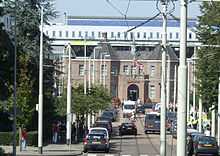Sparta Stadion Het Kasteel


Sparta-Stadion Het Kasteel (Dutch pronunciation: [ˈspɑr.ta ˌstaː.di.ˌjɔn ət ka.ˈsteːɫ]) is a football stadium in Rotterdam, Netherlands. It is the home ground of Sparta Rotterdam. It has a capacity of 11,026.
History and layout
The stadium is located in the neighbourhood of Spangen, where it was built in 1916 as Stadion Spangen based on a plan of the architects J.H. de Roos and W.F. Overeynder. The name "Het Kasteel" (The Castle) is derived from the small building with two small towers which backs onto the south-facing tribune (Kasteel Stand) of the stadium, which looks similar to a castle. This building is the only authentical remain of the original design. It was built in 1916. The castle building, which is currently located along the length of the pitch, was originally positioned behind one of the goals.
1928 Olympic Games
For the 1928 Summer Olympics in neighboring Amsterdam, the venue hosted two football games. The first was on 5 June when host nation Netherlands defeated Belgium 3-1 while the second was three days later when the Dutch team tied Chile 2-2.
Through the years, the stands of "Stadion Sparta" were often renovated and extended, but the most radical renovation took place in 1998 and 1999: the stadium was completely rebuilt according to a plan of the architects Zwarts & Jansma. During the renovation, the pitch was turned 90 degrees. At the same time, it was renamed ENECO-stadion, after its main sponsor. That name was soon replaced by the present Het Kasteel ("The Castle"), which had already been the popular nickname for the stadium ever since it was built.
The Castle was bought in November 2004 by businessman Hans van Heelsbergen, the manager of the textile company Hans Textiel and also the chairman of Sparta Rotterdam. Van Heelsbergen opened in this building a Sparta museum (and an outlet of Hans Textiel).
Tonny van Ede Stand
The Tonny van Ede stand is on the north side of the ground and stands along the length of the pitch, opposite the Kasteel Stand. The most expensive tickets are to be found here. It houses the changing rooms as well as the corporate boxes, the ticket office and the boardroom. The players' tunnel runs from the centre of this stand onto the pitch between the two dugouts. The stand was named after one of Sparta's most famous sons, Tonny van Ede, in 2010.
Denis Neville Stand
The lowest priced tickets for home fans are to be found in the Denis Neville Stand. This is at the east end of the ground behind one of the goals. It houses the more vocal supporters of the club and is usually the first stand to sell-out. The stand was named in honour of one of Sparta's most successful managers, Denis Neville.
Bok de Korver Stand
Opposite the Denis Neville Stand, the Bok de Korver Stand is assigned as the family stand but also houses the away fans. Formerly known as the West Stand, it was named after Sparta legend Bok de Korver.
Kasteel Stand
Attached to the historic Kasteel building, the Kasteel Stand is on the south end of the ground and the club shop is based here as well as the Sparta Museum.
External links
References
- FIFA.com 1928 Summer Olympics NED-BEL results from 5 June.
- FIFA.com 1928 Summer Olympics NED-CHI results from 8 June.
- RSSSF.com results from 1928 Summer Olympics football tournament.
| |||||
| |||||||
Coordinates: 51°55′10″N 4°26′01″E / 51.919485°N 4.433619°E
